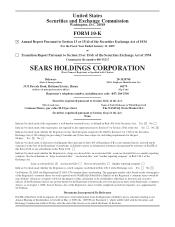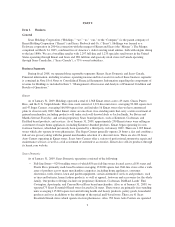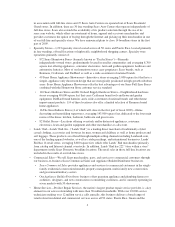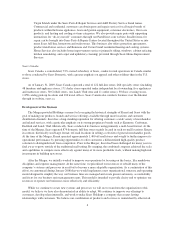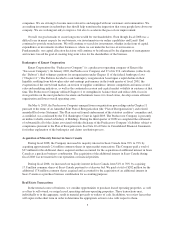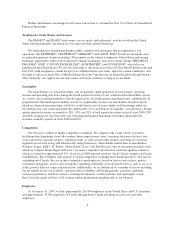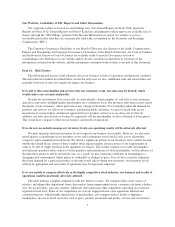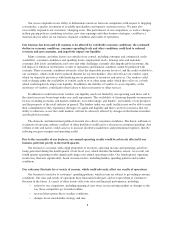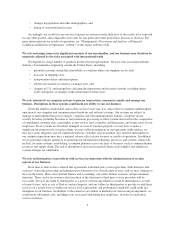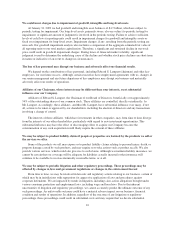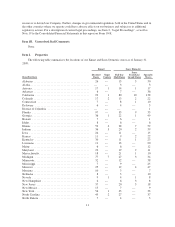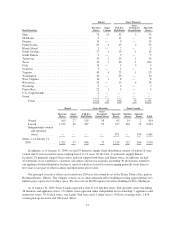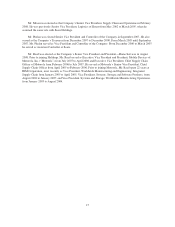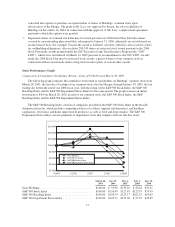Sears 2008 Annual Report Download - page 8
Download and view the complete annual report
Please find page 8 of the 2008 Sears annual report below. You can navigate through the pages in the report by either clicking on the pages listed below, or by using the keyword search tool below to find specific information within the annual report.Our success depends on our ability to differentiate ourselves from our competitors with respect to shopping
convenience, a quality assortment of available merchandise and superior customer service. We must also
successfully respond to our customers’ changing tastes. The performance of our competitors, as well as changes
in their pricing policies, marketing activities, new store openings and other business strategies, could have a
material adverse effect on our business, financial condition and results of operations.
Our business has been and will continue to be affected by worldwide economic conditions; the continued
decline in economic conditions, consumer-spending levels and other conditions could lead to reduced
revenues and gross margins, and negatively impact our liquidity.
Many economic and other factors are outside of our control, including consumer and commercial credit
availability, consumer confidence and spending levels, employment levels, housing sales and remodels,
consumer debt levels and inflation, fuel costs and other challenges currently affecting the global economy, the
full impact of which on our business, results of operations and financial condition cannot be predicted with
certainty. These economic conditions adversely affect the disposable income levels of, and the credit available to,
our customers, which could lead to reduced demand for our merchandise. Also affected are our vendors, upon
which we depend to provide us with financing on our purchases of inventory and services. Our vendors could
seek to change either the availability of vendor credit to us or other terms under which they sell to us, or both,
which could negatively impact our liquidity. In addition, the inability of vendors to access liquidity, or the
insolvency of vendors, could lead to their failure to deliver inventory or other services.
In addition to credit terms from vendors, our liquidity needs are funded by our operating cash flows and to
the extent necessary borrowings under our credit agreements. The availability of financing depends on numerous
factors, including economic and market conditions, our credit ratings, and lenders’ assessments of our prospects
and the prospects of the retail industry in general. The lenders under our credit facilities may not be able to meet
their commitments if they experience shortages of capital and liquidity and there can be no assurance that our
ability to otherwise access the credit markets, will not be adversely affected by changes in the financial markets
and the global economy.
The domestic and international political situation also affects consumer confidence. The threat, outbreak or
escalation of terrorism, military conflicts or other hostilities could lead to a decrease in consumer spending. Any
of these events and factors could cause us to increase inventory markdowns and promotional expenses, thereby
reducing our gross margins and operating results.
Due to the seasonality of our business, our annual operating results would be adversely affected if our
business performs poorly in the fourth quarter.
Our business is seasonal, with a high proportion of revenues, operating income and operating cash flows
being generated during the fourth quarter of our fiscal year, which includes the holiday season. As a result, our
fourth quarter operating results significantly impact our annual operating results. Our fourth quarter operating
results may fluctuate significantly, based on many factors, including holiday spending patterns and weather
conditions.
Our sales may fluctuate for a variety of reasons, which could adversely affect our results of operations.
Our business is sensitive to customers’ spending patterns, which in turn are subject to prevailing economic
conditions. Our sales and results of operations have fluctuated in the past, and we expect them to continue to
fluctuate in the future. A variety of other factors affect our sales and financial performance, including:
• actions by our competitors, including opening of new stores in our existing markets or changes to the
way these competitors go to market online,
• seasonal fluctuations due to weather conditions,
• changes in our merchandise strategy and mix,
8

